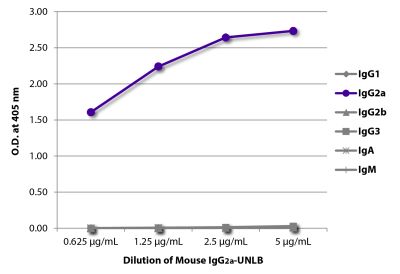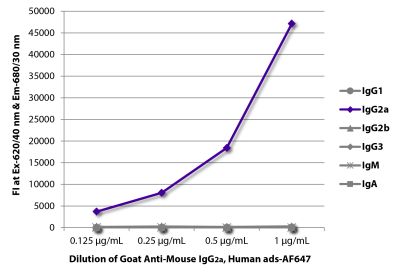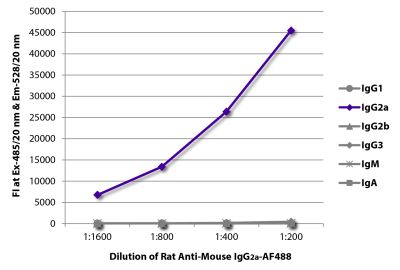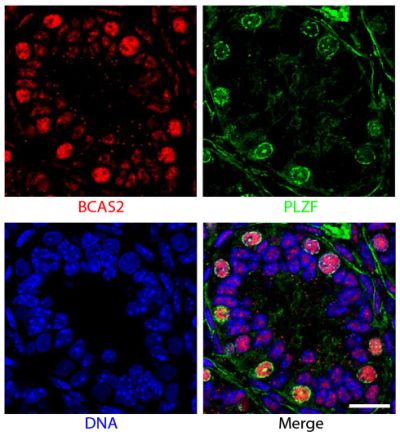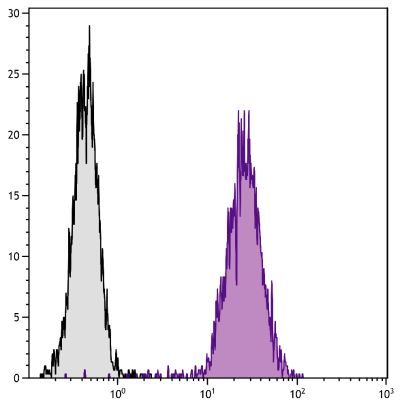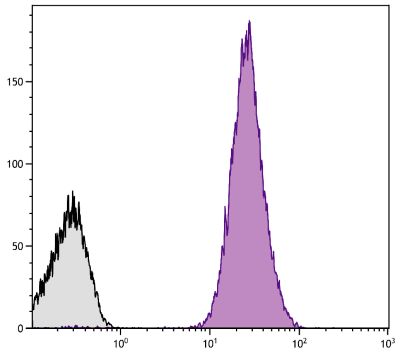Mouse Anti-Human CD49b-UNLB (HAS-4)
Cat. No.:
9426-01
Purified Anti-Human CD49b antibody for use in flow cytometry, immunohistochemistry / immunocytochemistry, immunoprecipitation, and blocking assays.
$114.00
| Clone | HAS-4 |
|---|---|
| Isotype | Mouse IgG2aκ |
| Isotype Control | Mouse IgG2a-UNLB (HOPC-1) |
| Specificity | Human CD49b |
| Alternative Names | Integrin α2, VLA-2α, very late antigen-2 |
| Description | CD49b, a member of the integrin family of extracellular matrix and cell adhesion molecules, is the integrin α2 chain. CD49b associates noncovalently with CD29, the integrin β1 subunit, to form the heterodimer integrin α2β1 that binds laminin and collagen. It is expressed on B and T lymphocytes, NK cells, monocytes, platelets, fibroblasts, and long-term cultured T cells. CD49b/CD29 mediates the Mg++-dependent adhesion of platelets to collagen. It may also be utilized by fibroblasts for the reorganization of the collagen matrix during wound healing. |
| Immunogen | Human keratinocytes |
| Conjugate | UNLB (Unconjugated) |
| Buffer Formulation | Borate buffered saline, pH 8.2 |
| Clonality | Monoclonal |
| Concentration | 0.1 mg/mL |
| Volume | 1.0 mL |
| Recommended Storage | 2-8°C |
| Applications |
Flow Cytometry – Quality tested 6,7 Immunohistochemistry-Frozen Sections – Reported in literature 2,3 Immunocytochemistry – Reported in literature 4 Immunoprecipitation – Reported in literature 1,2,6 Blocking – Reported in literature 5 |
| RRID Number | AB_2796790 |
| Gene ID |
3673 (Human) |
| Gene ID Symbol |
ITGA2 (Human) |
| Gene ID Aliases | BR; CD49B; GPIa; HPA-5; VLA-2; VLAA2 |
| UniProt ID |
P17301 (Human |
| UniProt Name |
ITA2_HUMAN (Human) |
Documentation
Certificate of Analysis Lookup
Enter the Catalog Number and Lot Number for the Certificate of Analysis you wish to view
- 1. Tenchini ML, Adams JC, Gilbert C, Steel J, Hudson DL, Malcovati M, et al. Evidence against a major role for integrins in calcium-dependent intercellular adhesion of epidermal keratinocytes. Cell Adhes Commun. 1993;1:55-66. (Immunogen, IP)
- 2. Berdichevsky F, Alford D, D-Souza B, Taylor-Papadimitriou J. Branching morphogenesis of human mammary epithelial cells in collagen gels. J Cell Sci. 1994;107:3557-68. (IP, IHC-FS)
- 3. Rikimaru K, Molès J, Watt FM. Correlation between hyperproliferation and suprabasal integrin expression in human epidermis reconstituted in culture. Exp Dermatol. 1997;6:214-21. (IHC-FS)
- 4. Malara A, Gruppi C, Rebuzzini P, Visai L, Perotti C, Moratti R, et al. Megakaryocyte-matrix interaction within bone marrow: new roles for fibronectin and factor XIII-A. Blood. 2011;117:2476-83. (ICC)
- 5. Alford D, Baeckström D, Geyp M, Pitha P, Taylor-Papadimitriou J. Integrin-matrix interactions affect the form of the structures developing from human mammary epithelial cells in collagen or fibrin gels. J Cell Sci. 1998;111:521-32. (Block)
- 6. Hangan D, Uniyal S, Morris VL, MacDonald IC, von Ballestrem C, Chau T, et al. Integrin VLA-2 (α2β1) function in postextravasation movement of human rhabdomyosarcoma RD cells in the liver. Cancer Res. 1996;56:3142-9. (IP, FC)
- 7. King SL, Kamata T, Cunningham JA, Emsley J, Liddington RC, Takada Y, et al. Echovirus 1 interaction with the human very late antigen-2 (integrin α2β1) I domain. Identification of two independent virus contact sites distinct from the metal ion-dependent adhesion site. J Biol Chem. 1997;272:28518-22. (FC)
See All References


